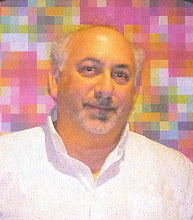I often characterize the difference between film and theatre as being a choice between verisimilitude and using one's own imagination. In film, nothing need be left to the viewer's imagination--and rarely is, making it a more passive experience. Live theatre depends upon each audience member's own camera lens, which doesn't always focus on where the director has chosen--the lens is always wide-angle without closeups even though there are theatrical conventions and the use of lighting to draw one's attention.
So, you can consider yourself an auteur when you attend the theatre.
These thoughts came to mind when we saw Sweeney Todd, the Demon Barber of Fleet Street this morning--the film musical, not the stage musical, directed by one of the world's greatest fantasists, Tim Burton.
Having seen previously only the televised version of the original production with George Hearn and Angela Lansbury, directed by Hal Prince, with its seemingly deliberate staginess underscoring the Grand Guignol bloodbath it portrays, I wondered if I'd be entering "nighttown"--the cartoonish underworld of The Nightmare Before Christmas and Sleepy Hollow and Corpse Bride.
Yup.
It makes the streetlife of Victorian London in the film Oliver! seem positively Disney-esque by comparison. And while the film medium's ability to produce vividly realistic imagery with no detail unillustrated is exploited to the fullest in Sweeney Todd, Tim Burton's hallmark fantasmic excesses always provide little reminders that what we're seeing is not real, but imagined.
Take, for example, his use of blood in the film, of which there is much spilled, dripped, drained, splattered and squirted. Redder than the makeup lining the underside of Johnny Depp's eyes, shinier than the gleaming mettalic orbs in a pinball machine and more viscous than the oil pooling up under my 15 year old car, this is not something anyone would mistake for "real."
How about the real cockroaches crawling amidst the filthy counters in Mrs. Lovett's meat pie shop? They look like real bugs to me, but the frequency and timing of their appearances are as choreographed as an Agnes de Mille number from Oklahoma. Ditto the rats on the streets and in the sewers.
One of the most telling exampes, early in the film, was after he arrives at the garrett above Mrs. Lovett's and the camera pulls back from the window to a wider aerial shot of London rooftops and forbidding, black cloudy skies, the scene goes dark entirely for a moment and as the camera continues to pull back we realize we've just passed through thick black smoke from a chimney across the street (symbolically foreshadowing the smoke from the basement crematorium Todd & Lovett later set up?).
This is not using the film medium's skill at verisimilitude to achieve perfect naturalism but rather to paint an unreal world, a world in the imagination of its creator--and ultimately a mechanism that provokes a little more than just a passive response from its viewers even if we are not using our imagination exactly the same way as we would in the live theatre.
It's exciting to experience, not least of which is the Stephen Sondheim musical it envelopes.
Until next time...
Rick
Friday, December 21, 2007
Subscribe to:
Post Comments (Atom)


No comments:
Post a Comment